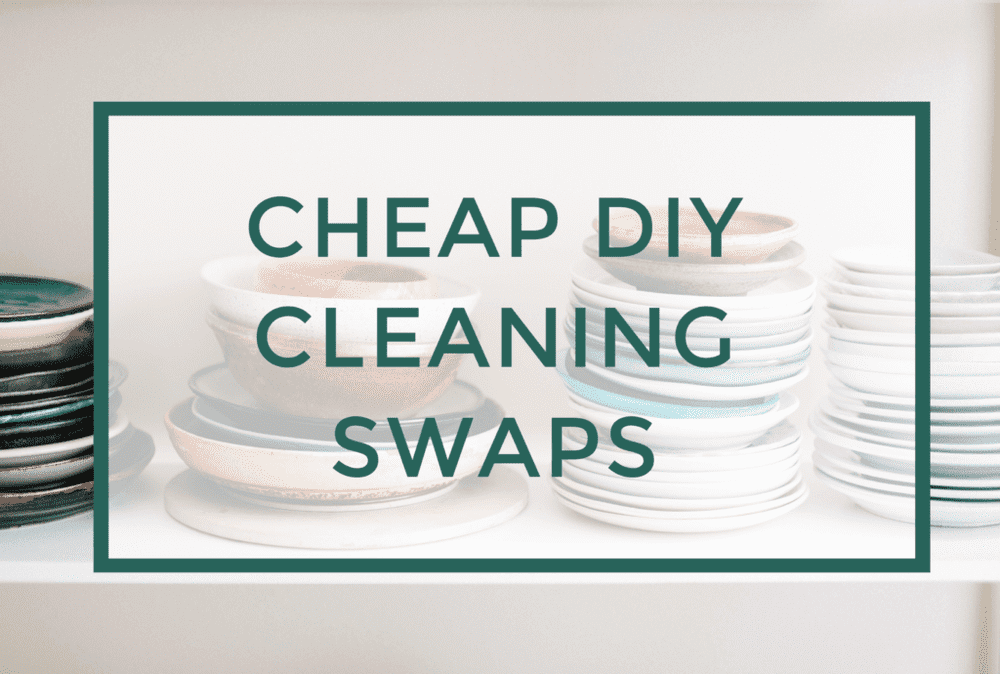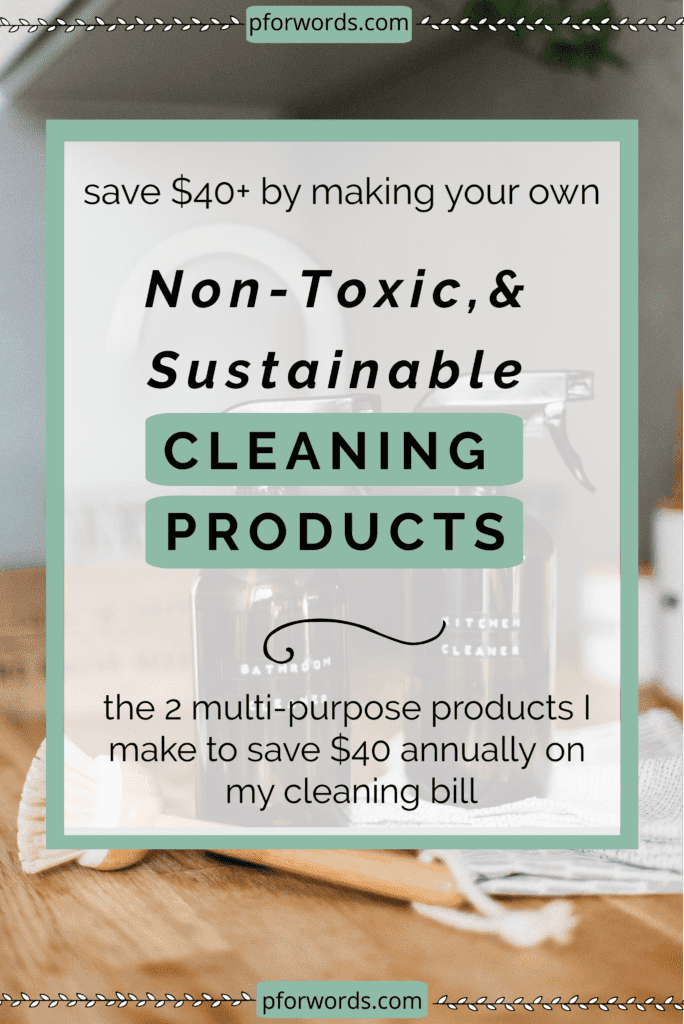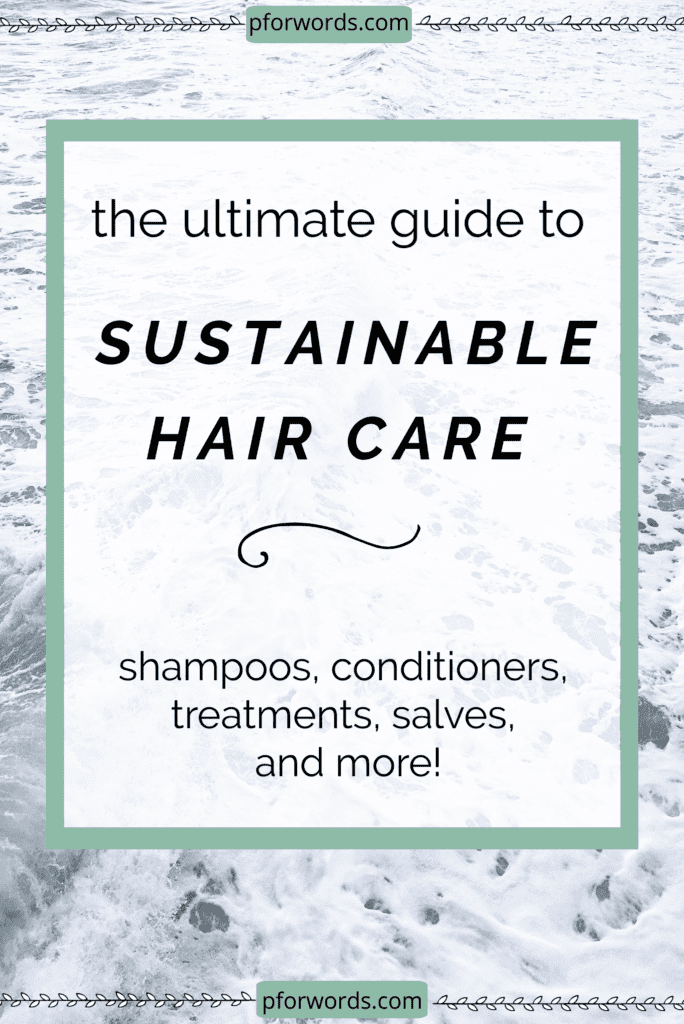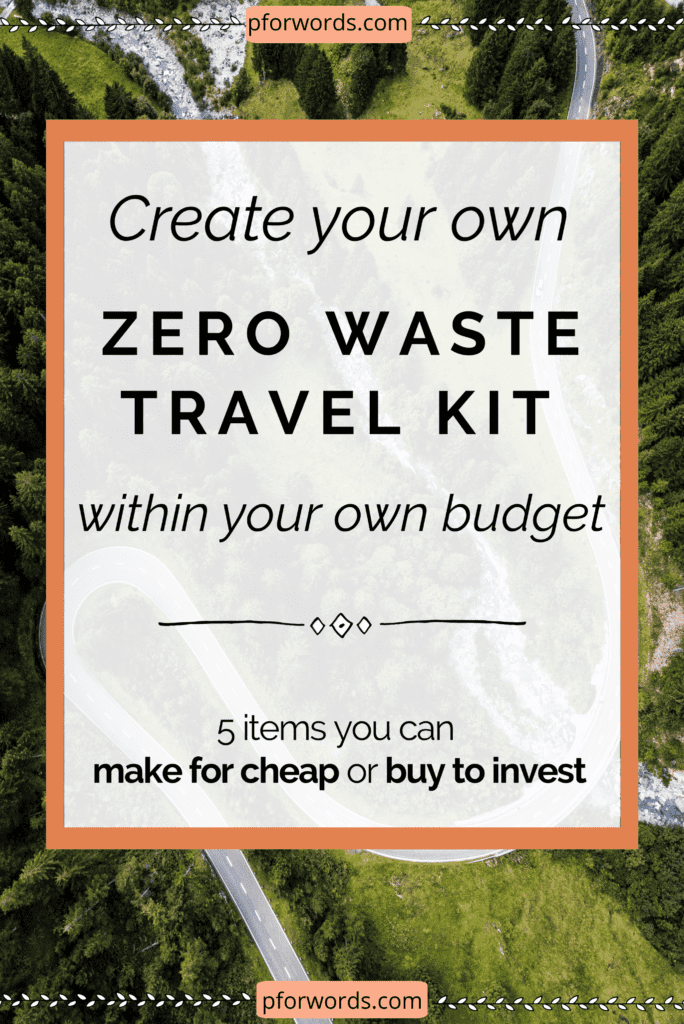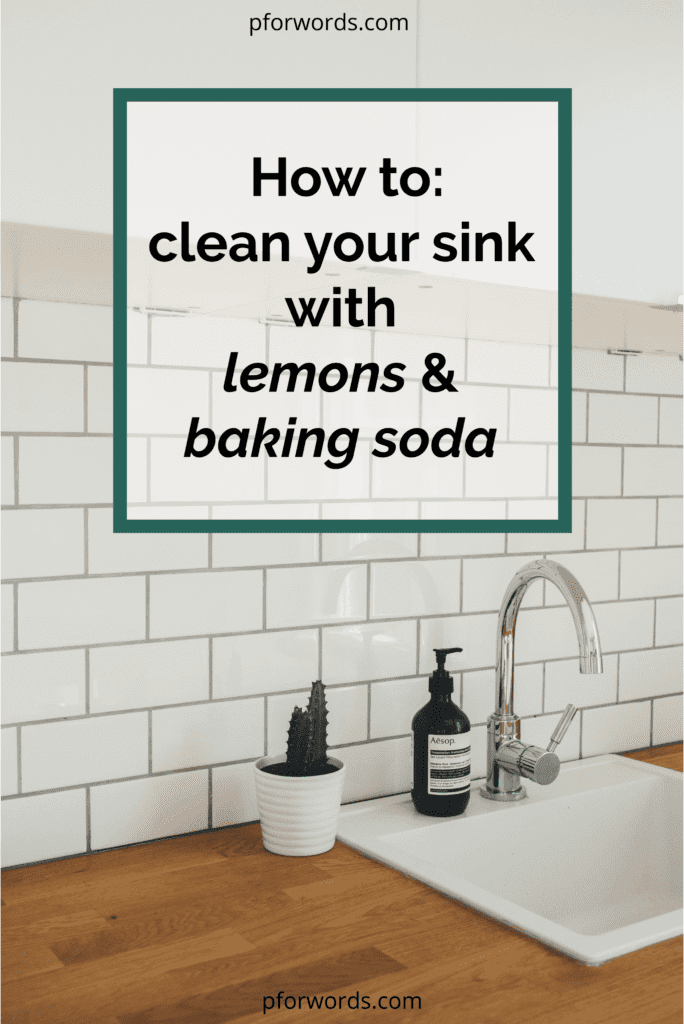DIY Zero Waste Cleaning Solutions to save $40 a Year
Zero waste cleaning solutions don't have to be complicated to make and can be just as effective as other traditional cleaners. The biggest difference between these and the ones you find on shelves in Target or Walmart is that you save those plastic bottles from the landfill and you prevent toxic chemicals from going down the drain (which hurts aquatic life).
In this post I'll break down why conventional cleaners are terrible for your health, what greenwashing is, what chemicals you should avoid in your cleaning products, and how you can make your own! Plus I'll also break down the cost difference to show you that making your own zero waste cleaning solutions will save you money!
The issue with conventional cleaners
The Environmental Working Group, a non-profit focused on public and environmental health, came out with their list “Cleaners Hall of Shame”.
They found, after extensive research as only 7% adequately disclosed their contents, 53% of cleaning products under review contained lung-harming ingredients.
In addition, well-known carcinogens like formaldehyde and chloroform were found in several cleaners.
Essentially, conventional cleaners are terrible for your health.
The chemical makeup of most conventional cleaners have also been linked to cancers, asthma, and reproductive or developmental health issues.
What is greenwashing and why is it happening?
The public, mainly concerned parents, have become increasingly concerned with the conventional products they bring into their homes and companies have caught on. This has led to a wave of corporate ‘greenwashing’. Since the term ‘green’ and ‘natural’ aren’t regulated by the government, companies can claim their products are ‘green’ and ‘natural’, without facts or action to back it up.
Essentially, these companies are trying to pull a fast one on their consumers.
To figure out if your products are being green-washed, I suggest you look at their ingredient list.
What ingredients should you always avoid for your health?
Stay away from petroleum distillates such as benzene, or 1,4 dioxane, both of which can cause cancer, not to mention the fact that they come from a non-renewable resource (oil) which is, in and of itself, far from eco-friendly. Check out this quick list of 10 other chemicals to avoid at all costs.
Not only are these cleaners bad for your health, but they are terrible for the environment.
Why are these toxic ingredients bad for the environment too?
Phosphorus, nitrogen, ammonia have been named by the U.S. Environmental Protection Agency as the worst environmental hazards in cleaners.
Ammonia is especially present in multi-purpose cleaners is a multipurpose household cleaner that is found in many cleaning products that do everything from degreasing to sanitizing and removing allergens. Nitrogen is found in many glass and surface cleaning products.
The lifecycle of the chemicals in our waterways:
- When these chemicals end up going down the drain (cleaning your bathtub, toilets, or chemical-soaked rags in the wash), they enter the waterways and build up, causing an accelerated growth of some types of plant life.
- Dense vegetation clogs waterways and can crowd out animal life and other marine plants.
- As they die in large masses, they deplete the oxygen in the water (science stuff).
- Algae then grows, and the animals die off as well; the die-offs cause more decay. The water quickly becomes no longer suitable for drinking, cooking, or bathing.
On top of the chemicals being terrible for our water, most, if not all, conventional cleaners come in plastic containers.
Plastic is the devil incarnate: it’s virtually impossible to biodegrade, the little shit stays with us forever. Plastic items do break down, but only into tiny micro-beads that are harder to clean up and consumed by marine life that mistake it for food.
Then that plastic moves up the food chain, including into OUR diet – every fish sold for human consumption contains an average of 11 pieces of plastic.
But it doesn't have to be this way.
You don't have to feel guilty about polluting the environment and possibly damaging your health by just cleaning your house. Instead, check out these natural, DIY cleaning products that are not only good for the environment and your health, but will save you a bit of cash in the long run!
Make your own cleaning products
Cheap cleaners come a high price for your health. But that doesn’t mean alternative, eco-friendly cleaners have to be expensive. On the contrary, I spend less on my cleaning products now than ever before.
I avoid accidentally bringing in harmful chemicals into your house, try these cleaning swaps! Not only will this benefit your health, but it will also benefit your wallet.
Zero Waste Cleaner: All-Purpose Spray
Ingredient used in my All-purpose Cleaner:
Vinegar.
That's right, that's the only active ingredient!
QUICK NOTE: Only use this on no-natural stone surfaces. You should not use this on marble, granite, or other mineral surfaces as the vinegary will dull the stone's shine.
Why does vinegar work well?
“Vinegar is about 5 percent acetic acid. The acid kills bacteria and viruses, by chemically changing the proteins and fats that make up these nasties and destroying their cell structures.”
This makes vinegar a fantastic all-purpose disinfectant!
Make your own vinegar cleaner:
Mix 50% water with 50% vinegar.
If I’m feeling fancy, I’ll presoak my vinegar with lemon wedges I’ve used during the week and/or essential oils.
Does it smell funny?
Yes, the spray does smell like vinegar.
If you do soak citrus peels or add essential oils, that will help make it smell less vinegary.
But it does not smell like the fake lemon scent created by unregulated chemicals in conventional cleaners that most of us have become accustomed to.
Once you switch over to this lifestyle and give your nose a break from those chemicals, you’ll become repulsed by those artificial smells. Well, at least I did. They actually make me nauseous.
I personally like the smell of this spray. But even if you don’t, it only stays for a minute or two.
Price comparison:
My cleaner:
White Vinegar + Water
Cost: \$1.29 / 16 oz.
Mix this with 16 oz of water and you get 32 oz of cleaning solution for \$1.29
Conventional cleaner:
Cost: \$2.30 /32 fluid oz
Unit Savings by switching to my zero waste alternative :
\$1.01
Annual savings:
\$6.06
(Assuming we go through 6 bottles of this per year)
Zero Waste Cleaner: Deep Scrub
*Queue the infomercial music*
Need to get a bit for a deeper clean? Tackling the bathroom? Need to get rid of some grime stains? This is the cleaning scrub for you.
Ingredients used in my homemade scrub:
Castile soap, baking soda, and tea tree oil.
Castile soap is made from oils and completely saponified potassium hydroxide and will clean without drying out your hands. Like other soaps, this plant-based version efficiently loosens grime and dirt from surfaces.
(If you can’t find Castille soap in bulk, I recommend buying this one (in their largest plastic bottle to help mitigate your plastic use)
Baking soda removes stains, sanitizes, deodorizes, polishes, cuts through grease and much more.
Tea tree oil has anti-viral and anti-bacterial qualities to help disinfect.
Make your own scrub!
Ingredients
- ¼ cup Castile Soap
- ¾ cup baking soda.
- Opt: 20 drops of tea tree oil
Unit Price Breakdown
- Cost of 2 oz of Castille soap = \$0.93
- Cost of ¾ cup of baking soda: \$1.68
- Cost of 20 drops of tea tree oil: \$0.33
My Scrub Price: \$1.89
Traditional Cleaner Price (Tilex): \$4
Unit savings by switching to a zero-waste alternative:
\$2.11
Annual savings:
\$4.22
(Assuming we go through 2 bottles/ scrub recipes per year.)
My Materials
To do all this cleaning I utilize two things.
Reusable cloths
Instead of using single-use paper towels, I suggest using cloths! I made my own by cutting up old t shirts and sheets. If you can’t do this, then I suggest checking out your local thrift store for old clothes, towels, or t shirts. If you still want to buy new, try these.
Cost of cloths:
Assuming you make your own with old tshirts, sheets, and/or towels :\$0
Annual cost of cloths: \$0
Cost of Paper towels:
Assuming you use one roll a month: 10/8*12= 15
Annual cost of paper towels: \$15
Total annual savings by switching to cloths:
\$15
Scrubbers
I migrate these from my kitchen after they’ve taken a hard beating from cleaning my dishes. I normally make mine last about 6 months (whereas when I was pre-zero waste, I used a new sponge every 2 weeks mainly due to the direct contact my fingers made with the yucky sponge).
Side note: sponges harbor crazy amounts of bacteria) and studies have found that boiling or washing them doesn’t help.
Annual Cost of sustainable pot scrubbers:
Pot scrubbers: \$12
(Assuming you use a new one every 6 months.)
Annual Cost of plastic sponges:
Conventional sponges: \$30
(Assuming you use a new one every two weeks.)
Total savings by switching to a sustainable scrubber:
\$18
Total Annual Savings from Zero Waste Cleaning Solutions Routine:
\$40
Wrapping it up!
Honestly, those are the only two things I clean with. Put in a little elbow grease and you’ll be able to clean everything with these two things because they are super effective.
A benefit of living a zero waste lifestyle is that you realize you don’t need a whole lot of stuff to do the same job. Reducing your environmental impact means cutting down on resource utilization as it takes energy to produce everything. You start to inadvertently pair down your life, cleaning routine included.
So ultimately, have a zero waste cleaning routine will save the environment, your wallet, and your time! Triple win!
Pin & save this for later!
You May Also Like
Hi, I'm Taylor
Amateur adult. Zero waste zealot. Personal finance fiend. Spicy food supporter. I’m an mid 20’s gal living in Denver, Colorado. My love of the outdoors has cultivated my zero waste lifestyle, which inadvertently fueled my passion for personal finance. Cheers to everyone interested in lessening their footprint while growing their wallet!
